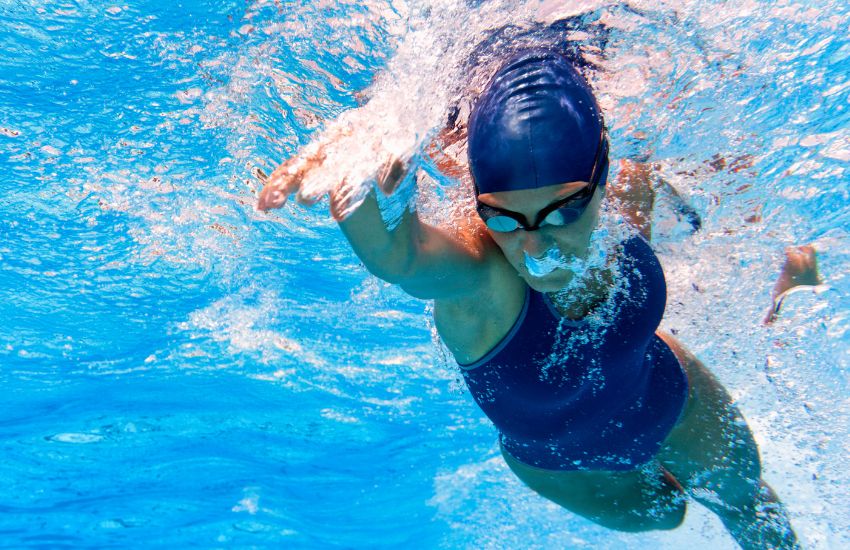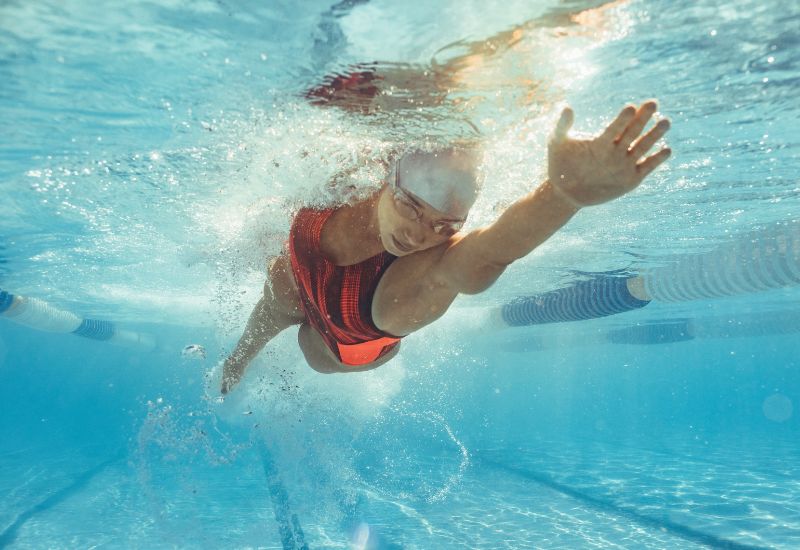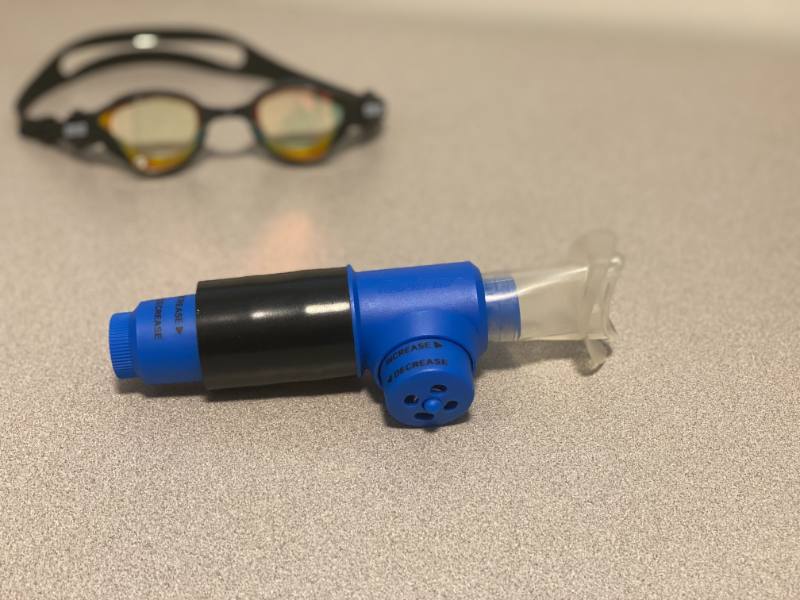Conquer the pool by conquering your breath. Here is the ultimate guide to how to breathe when swimming, including how to time the breath and some sets to improve your breathing.
Swimming is one of the best ways to get an awesome workout in the pool.
And one of the biggest challenges swimmers face, from beginner to experienced, is breathing properly and optimally when churning up and down the lane.
Breathing serves a couple of important and obvious functions in the water—sucking in oxygen feeds your muscles,
But improper form when breathing is one of the most common mistakes swimmers make.
Turning the head too far throws the body out of position. Picking the head up too high snow-plows our forehead, halting forward momentum.
And not breathing properly leaves us feeling perpetually winded (and frustrated) when swimming.
There’s a better way.
In this article, we will discuss the basics of breathing when swimming, outline our favorite tips for nailing your breath, and offer two strategies for becoming a “stronger” breather in the pool.
By the end, breathing in the water will become second-nature to the point that you can forget about breathing and focus on awesome technique and swimming your brains out in the pool.
Let’s dive right in.
How to Improve Breathing Technique When Swimming
There are three things to keep in mind when trying to nail your breath while swimming.
Here is how to approach the entire breath cycle so that you can swim more efficiently and less like you are doing controlled drowning:
1. Remember to relax while swimming.
Harder done than said, I know!
Every instinct in your body is screaming at you to tense up and freak out when your face is pointing downwards in the water and there is no oxygen in sight.
Aim to have a breathing pattern that is similar in terms of relaxation to when you are running or cycling.
A tense upper body and face increases anxiety, burns energy and oxygen, and leads to feeling short of breath.
2. Controlled exhale under the water.
When swimming hard, and the inhale-exhale cycle accelerates, swimmers will exhale completely the moment their head faces down in the water, leaving them out of air as they complete their arm stroke cycle.
This results in gasping and picking the head up scrambling for air.
Instead, do a controlled exhale.
Not only will this reduce the onset of panic that happens when your lungs empty of air, but you will become far more disciplined in how you breathe in the water.
A controlled exhale also means you won’t be gasping for air when you come up for your next breath.
Tip: You don’t need to hold your breath under the water. Slowly emitting air helps to avoid the “panic” reflex that naturally occurs when we are face down in the water.
3. Sharp, deep inhalation.
After you’ve completed you exhalation, the cycle of strokes is completed, it’s time to turn your head and gulp down some more of that free-range air (and oxygen!).
For freestyle (front crawl, for the new kids in the class), turn your head so that one goggle is out of the water and your head is straight with your neck and back (head-spine line).
The bow wave being created by your forehead will create a depression of water that gives the mouth access to air.
Inhale deeply and quickly.
When swimmers take a long and slow inhalation, or they pick the head up to take that breath, body position falls out of whack, with the hips sinking.
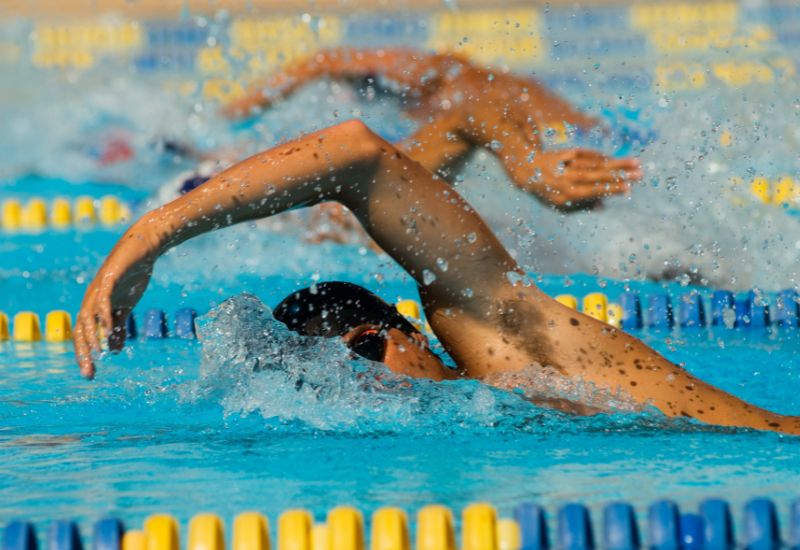
A quick and deep inhalation allows you to get your face and body back into the most hydrodynamic position possible, which is straight and face down in the water.
As we will see in a bit, you can get better at sucking in more air, more quickly, with the help of some breath training tools.
Tip: The breathing cycle is not 1:1 when swimming. Inhalations are done short and deeply, exhalations are done controlled and slowly.
How to Time Your Breath When Swimming
Properly timing the breath when swimming is one of the hardest parts of mastering the sport.
Even elite and very experienced swimmers have breath timing dysfunction, typically as a result of breathing too late in the stroke cycle.
This kind of boo-boo results in a cascading series of errors in the stroke, from a loss of rhythm, over-rotation, improper catch, the kick going too wide, and so on.
Here are some tips for timing your breath while swimming:
Turn the head before you turn the body.
Timing your breathing properly requires two rotations: The head turns, and then the body rotates.
Swimmers will often use their entire body to turn the face out of the water. Not necessary!
And this full-body rotation is wildly inefficient in the water.
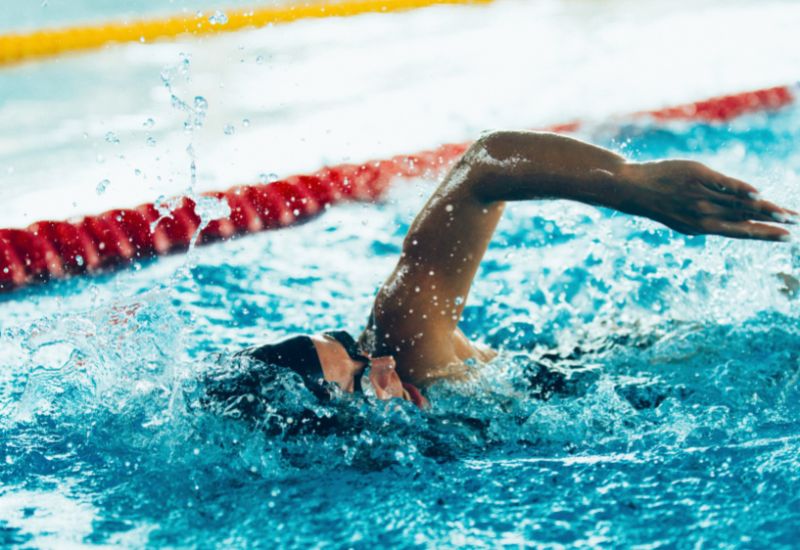
Turn the head, and then rotate the body.
This two-stage rotation prevents over-rotation and “face up” breathing and also “look back” breathing.
This is the biggest part of breathing properly when swimming, so try it in the water, try it sitting at your desk, and get used to the 1-2 rotation.
Watch the breathing arm.
Another cue for ensuring a quick inhalation is that the head should return to the “down” position before the breathing-side arm extends out in front of you.
You should be able to watch the extension of your hand and the catch after you’ve taken a breath.
This requires breathing early in the stroke cycle.
The benefits of breathing early in the arm stroke include being in a more streamlined position and getting more power out of your next stroke.
In the video below, Olympic gold medalist in the 100m freestyle Nathan Adrian demonstrates how to breathe properly when swimming.
Note that his head is face-down in the water before the breathing side arm lands in the water, nailing that “early” breath in the stroke cycle.
How to Strengthen Your Breathing While Swimming
There are two tried-and-true swimmers can do to strengthen their breath when swimming.
One can be done at the pool, the other in the comfort of your pajamas at home.
They include:
1. Controlled breathing.
One of the things intermediate swimmers learn is breathing using specific stroke counts. This type of work goes by a few different names, including “Lungbuster Sets.”
Ultimately, it comes down to breathing every X number of strokes. For example, during freestyle sets when doing pull, breathe every 3 or 5 strokes.
Fun fact: Controlled-frequency breath swimming has been shown to improve swim performance and improve muscle oxygen utilization in and out of the pool1.
One popular example from competitive swimming days was doing 400s of pull, breathing 3-5-7-9 strokes by 100.
Designating specific sets during your swim workouts for breath work is a great way to build confidence and improve your breathing when swimming.
Other ways to do controlled breathing when swimming is not to breathe in and out of the turns and extend your underwaters off each wall.
2. Use a respiratory training device.
Another way to build up your breathing muscles is using a respiratory device.
These tools are like strength training for your lungs, requiring additional effort to inhale and exhale.
I invested in a PowerLung a few years back and absolutely love how effective it has been in helping “train” a deeper and more powerful breath.
A study with elite age group swimmers found that six weeks of respiratory training resulted in an increased 1.7% improvement in a 100m freestyle time trial performance compared to their teammates who didn’t train with the device2.
Use a device like this for a few weeks and you will notice that you can suck in a TON more air when swimming.
The best part about these devices is that you can use them on dryland when you are away at the pool.
Pro Tip: Use a respiratory device before your next swim to give your pulmonary system a warm-up. You’ll find that you are less out-of-breath when starting out your swim workout.
Sets for Improving Breath When Swimming
When it comes to improving your breath when swimming, there are two key things to remember:
First, your lungs should be warmed up like any other body part.
Introduce some breath control early into your swim workouts to get the pulmonary system prepped for the hard stuff to come later.
After a general warm-up, try this breath-control set before the main set:
- 10 x 50m freestyle pull @ :20 rest between reps. Breathe every 3 strokes on the first 25, and then every 5 strokes on the second 25.
And second, the more breath control work you do at the pool, the more confident you will be with your breathing.
One of the most frequent sets I did when I was training for Olympic Trials was a variation of the following Lungbuster Sets:
- 10 x 200m freestyle pull with swim paddles @ :20 rest between reps. Breathe 3-5-7-9 by each 50m.
- 10 x 300m freestyle pull with swim paddles @ :20 rest between reps. Breathe 5-7-9 by each 100m.
Using a pull buoy with breath control sets is “easier” compared to regular swimming with a kick, as the big muscles in your legs aren’t soaking up all the oxygen from your breath.
Start these types of sets with a pull buoy and transition to swim as your breath control skills get better.
How to Breathe When Swimming – FAQs
Do you breathe through the nose or mouth when swimming?
Breathing mostly through the mouth is more natural as you can gulp down more air, faster, making the mouth the primary “inhalation” source.
Exhalation is also better controlled through the mouth (in my experience).
Ultimately, it’s not one or the other, as regulating pressure under the water necessitates that you exhale through the nose, as well.
Use both to get maximal air in, and use the combo that feels most controlled and natural when exhaling under the surface.
How do you get over swimming breathing anxiety?
For absolute beginners, a favorite drill is doing deep water bobs to simulate the same breathing tempo when swimming.
Jump in the pool, take a quick and deep breath and then sink to the bottom of the pool, slowly exhaling.
When you get to the bottom, do a squat jump back towards the surface, and as you exit the water, take a big breath before dipping back under, repeating the cycle.
Deep water bobs simulate the timing and experience of breathing when swimming and can help you get comfortable with breathing in the pool.
The Bottom Line
There is perhaps nothing more enjoyable than getting better in the water.
Being able to cross the pool faster, more efficiently, and without gasping and grasping for air, creates the motivation and confidence to keep coming back to the pool.
Breathing better when swimming is one of the best things to focus on for better and faster swimming.
To recap:
- Relax the face and upper body
- Inhale sharply and deeply, use a controlled exhale
- Turn the head, and then the body to breathe
- Breathe early in the stroke cycle
- Use breath work sets and consider investing in a respiratory training device
You will be breathing better and swimming faster in no time!
More Guides Like This
10 Freestyle Drills for a Faster Freestyle. Power up your freestyle with 10 freestyle drills from some of the best coaches and swimmers on the planet.
7 Tips for Improving Your Freestyle Stroke. Unlock a faster and more efficient freestyle stroke with this list of seven proven tips for killer freestyle technique.

